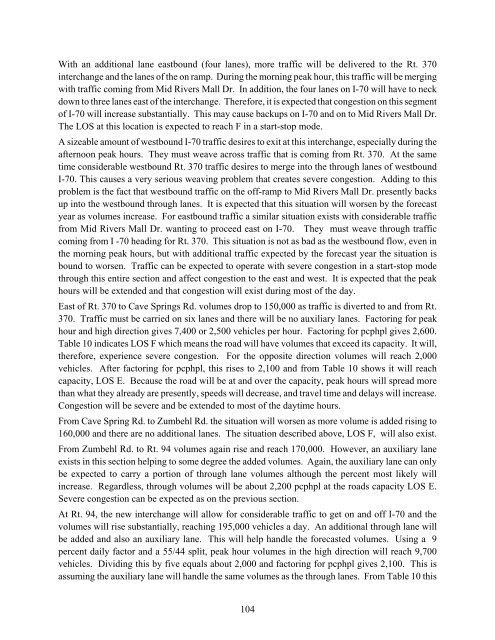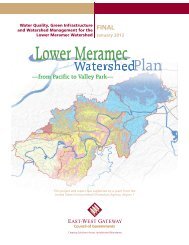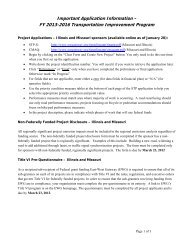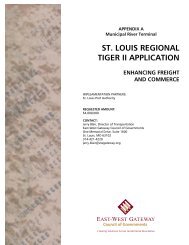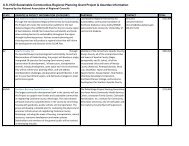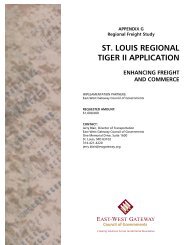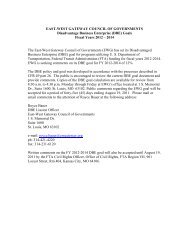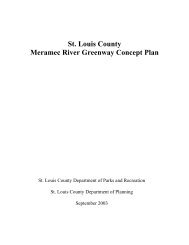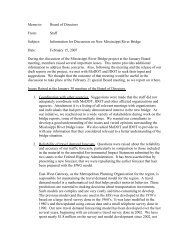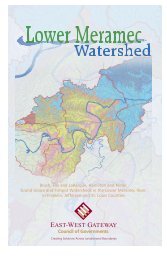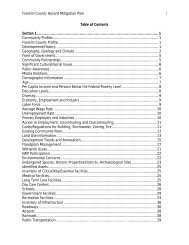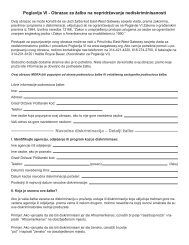St. Charles County Transportation Plan 2030 - East-West Gateway ...
St. Charles County Transportation Plan 2030 - East-West Gateway ...
St. Charles County Transportation Plan 2030 - East-West Gateway ...
Create successful ePaper yourself
Turn your PDF publications into a flip-book with our unique Google optimized e-Paper software.
With an additional lane eastbound (four lanes), more traffic will be delivered to the Rt. 370<br />
interchange and the lanes of the on ramp. During the morning peak hour, this traffic will be merging<br />
with traffic coming from Mid Rivers Mall Dr. In addition, the four lanes on I-70 will have to neck<br />
down to three lanes east of the interchange. Therefore, it is expected that congestion on this segment<br />
of I-70 will increase substantially. This may cause backups on I-70 and on to Mid Rivers Mall Dr.<br />
The LOS at this location is expected to reach F in a start-stop mode.<br />
A sizeable amount of westbound I-70 traffic desires to exit at this interchange, especially during the<br />
afternoon peak hours. They must weave across traffic that is coming from Rt. 370. At the same<br />
time considerable westbound Rt. 370 traffic desires to merge into the through lanes of westbound<br />
I-70. This causes a very serious weaving problem that creates severe congestion. Adding to this<br />
problem is the fact that westbound traffic on the off-ramp to Mid Rivers Mall Dr. presently backs<br />
up into the westbound through lanes. It is expected that this situation will worsen by the forecast<br />
year as volumes increase. For eastbound traffic a similar situation exists with considerable traffic<br />
from Mid Rivers Mall Dr. wanting to proceed east on I-70. They must weave through traffic<br />
coming from I -70 heading for Rt. 370. This situation is not as bad as the westbound flow, even in<br />
the morning peak hours, but with additional traffic expected by the forecast year the situation is<br />
bound to worsen. Traffic can be expected to operate with severe congestion in a start-stop mode<br />
through this entire section and affect congestion to the east and west. It is expected that the peak<br />
hours will be extended and that congestion will exist during most of the day.<br />
<strong>East</strong> of Rt. 370 to Cave Springs Rd. volumes drop to 150,000 as traffic is diverted to and from Rt.<br />
370. Traffic must be carried on six lanes and there will be no auxiliary lanes. Factoring for peak<br />
hour and high direction gives 7,400 or 2,500 vehicles per hour. Factoring for pcphpl gives 2,600.<br />
Table 10 indicates LOS F which means the road will have volumes that exceed its capacity. It will,<br />
therefore, experience severe congestion. For the opposite direction volumes will reach 2,000<br />
vehicles. After factoring for pcphpl, this rises to 2,100 and from Table 10 shows it will reach<br />
capacity, LOS E. Because the road will be at and over the capacity, peak hours will spread more<br />
than what they already are presently, speeds will decrease, and travel time and delays will increase.<br />
Congestion will be severe and be extended to most of the daytime hours.<br />
From Cave Spring Rd. to Zumbehl Rd. the situation will worsen as more volume is added rising to<br />
160,000 and there are no additional lanes. The situation described above, LOS F, will also exist.<br />
From Zumbehl Rd. to Rt. 94 volumes again rise and reach 170,000. However, an auxiliary lane<br />
exists in this section helping to some degree the added volumes. Again, the auxiliary lane can only<br />
be expected to carry a portion of through lane volumes although the percent most likely will<br />
increase. Regardless, through volumes will be about 2,200 pcphpl at the roads capacity LOS E.<br />
Severe congestion can be expected as on the previous section.<br />
At Rt. 94, the new interchange will allow for considerable traffic to get on and off I-70 and the<br />
volumes will rise substantially, reaching 195,000 vehicles a day. An additional through lane will<br />
be added and also an auxiliary lane. This will help handle the forecasted volumes. Using a 9<br />
percent daily factor and a 55/44 split, peak hour volumes in the high direction will reach 9,700<br />
vehicles. Dividing this by five equals about 2,000 and factoring for pcphpl gives 2,100. This is<br />
assuming the auxiliary lane will handle the same volumes as the through lanes. From Table 10 this<br />
104


